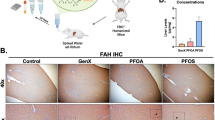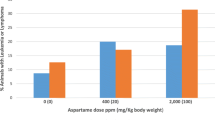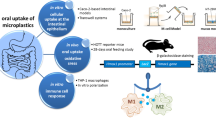Summary
The formation ofO 6-methyldeoxyguanosine (O 6-MedGuo) was determined by an immuno-slot-blot assay in DNA of various tissues of F344 rats exposed toN-methyl-N-nitrosourea (MNU) in the drinking water at 400 ppm for 2 weeks. Although the pyloric region of the glandular stomach is a target organ under these experimental conditions, the extent of DNA methylation was highest in the forestomach (185 μmolO 6-MedGuo/mol guanine). Fundus (91 μmol/mol guanine) and pylorus (105 μmol/mol guanine) of the glandular stomach, oesophagus (124 μmol/mol guanine) and duodenum (109 μmol/mol guanine) showed lower levels ofO 6-MedGuo but differed little between each other. Thus, no correlation was observed between target organ specificity and the extent of DNA methylation. This is in contrast to the gastric carcinogen,N-methyl-N′-nitro-N-nitrosoguanidine (MNNG), which preferentially alkylates DNA of the pylorus, the main site of induction of gastric carcinomas by this chemical. In contrast to MNU, the non-enzymic decomposition of MNNG is accelerated by thiol compounds (reduced glutathione,l-cysteine), which are present at much higher concentrations in the glandular stomach than in the forestomach and oesophagus. During chronic exposure to MNNG (80 ppm), mucosal cells immunoreactive toO 6-MedGuo are limited to the luminal surface [Kobori et al. (1988) Carcinogenesis 9:2271–2274]. Although MNU (400 ppm) produced similar levels ofO 6-MedGuo in the pylorus, no cells containing methylpurines were detectable by immunohistochemistry, suggesting a more uniform methylation of mucosal cells by MNU than by MNNG. After a single oral dose of MNU (90 mg/kg) cells containing methylpurines were unequivocally identified using antibodies toO 6-MedGuo and the imidazole-ring-opened product of 7-methyldeoxyguanosine. In the gastric fundus, their distribution was similar to those methylated by exposure to MNNG, whereas the pyloric region contained immunoreactive cells also in the deeper mucosal layers. After a 2-week MNU treatment, the rate of cell proliferation, as determined by bromodeoxyuridine immunoreactivity, was only slightly enhanced in the oesophagus and in the fundus, but markedly in the forestomach and the pyloric region of the glandular stomach. It is concluded that the overall extent of DNA methylation, the distribution of alkylated cells within the mucosa and the proliferative response all contribute to the organ-specific carcinogenicity of MNU.
Similar content being viewed by others
Abbreviations
- MNU:
-
N-methyl-N-nitrosourea
- MNNG:
-
N-methyl-N′-nitro-N-nitrosoguanidine
- O 6-MedGuo:
-
O 6-methyldeoxyguanosine
- 7-MedGuo:
-
7-methyldeoxyguanosine (imidazole ring open)
- BrdUrd:
-
bromodeoxyuridine
References
Boyd SC, Sasame HA, Boyd MR (1979) High concentrations of glutathione in glandular stomach: possible implications for carcinogenesis. Science 205:1010–1012
Druckrey H, Preussmann R, Schmähl D, Müller M (1961) Erzeugung von Magenkrebs durch Nitrosamide an Ratten. Naturwissenschaften 258–259
Druckrey H, Ivancovic S, Preussmann R (1964) Erzeugung von Hirntumoren bei Ratten durch Methylnitrosoharnstoff. Naturwissenschaften 51:144
Druckrey H, Ivankovic S, Preussmann R (1965) Selektive Erzeugung maligner Tumoren im Gehirn und Rückenmark von Ratten durchN-methyl-N-nitrosoharnstoff. Z Krebsforsch 69:389–408
Druckrey H, Preussmann R, Ivankovic S, Schmähl D (1967) Organotrope carcinogene Wirkungen bei 65 verschiedenenN-Nitroso-Verbindungen an BD-Ratten. Z Krebsforsch 69:103–201
Ey PL, Ashman LK (1986) The use of alkaline phosphatase-conjugated anti-immunoglobulin with immunoblots for determining the specificity of monoclonal antibodies to protein mixtures. Methods Enzymol 121:497–509
Fujita M, Ishii T, Tsukahara Y, Shimozuma K, Nakano Y, Taguchi T, Hirota N (1989) Establishment of the optimum conditions for induction of stomach carcinoma in rats by continous oral administration ofN-methyl-N-nitrosourea. J Toxicol Pathol 2:27–32
Hirota N, Aonuma T, Yamada S, Kawai T, Saito K, Yokoyama T (1987) Selective induction of glandular stomach carcinoma in F344 rats byN-methyl-N-nitrosourea. Jpn J Cancer Res 78:634–638
Kleihues P, Magee P (1973) Alkylation of rat brain nucleic acids byN-methyl-N-nitrosourea and methyl methanesulphonate. J Neurochem 20:595–606
Kleihues P, Margison GP (1974) Carcinogenicity ofN-methyl-N-nitrosourea: possible role of excision repair of O6-methylguanosine from DNA. J Natl Cancer Inst 53:1839–1941
Kleihues P, Patzschke K (1971) Distribution ofN-[14C]methyl-N-nitrosourea in the rat after systemic application. Z Krebsforsch 75:193–200
Kobori O, Schmerold I, Ludeke B, Ohgaki H, Kleihues P (1988) DNA methylation in rat stomach and duodenom following chronic exposure toN-methyl-N′-nitro-N-nitrosoguamdine and the effect of dietary taurocholate. Carcinogenesis 9:2271–2274
Koenigsmann M, Schmerold I, Jeltsch W, Ludeke B, Kleihues P, Wiessler M (1988) Organ and cell specificity of DNA methylation byN-nitrosomethylamylamine in rats. Cancer Res 48:5482–5486
Lawley PD, Shah SA (1972) Methylation of ribonucleic acid by the carcinogens dimethyl sulphate,N-methyl-N-nitrosourea andN-methyl-N′-nitrp-N-nitrosoguanidme. Comparisons of analyses at the nucleoside and base levels. Biochem J 128:117–132
Ludeke BI, Kleihues P (1988) Formation and persistence of O6-(2-hydroxyethyl)-2′-deoxyguanosine in DNA of various rat tissues following a single dose ofN-nitroso-N-(2-hydroxyethyl)urea. An immuno-slot-blot study. Carcinogenesis 9:147–151
Maekawa A, Matsuoka C, Onodera H, Tanigawa H, Furuta K, Ogiu T, Mitsumori K, Hayashi Y (1985) Organspecific carcinogenicity ofN-methyl-N-nitrosourea in F344 and ACI/N rats. J Cancer Res Clin Oncol 109:178–182
Margison GP, Kleihues P (1975) Chemical carcinogenesis in the nervous system. Preferential accumulation ofO 6-methylguanine in rat brain deoxyribonucleic acid during repetive administration ofN-methyl-N-nitrosourea. Biochem J 148:521–525
McKay AF, Wright GF (1947) Preparation and properties ofN-methyl-N′-nitro-N-nitrosoguanidine. J Am Chem Soc 69:3028–3030
Menkveld GJ, Van Der Laken CJ, Hermsen T, Kriek E, Scerer E, Den Engelase L (1985) Immunohistochemical localization ofO 6-ethyldeoxyguanosine and deoxyguanosin-8-yl-(acetyl) aminofluorene in liver sections of rats treated with diethylnitrosamine, ethylnitrosourea orN-acetylaminofluorene. Carcinogenesis (Lond) 6:263–270
Montesano R, Bresil H, Degan P, Martel-Planche G, Serres M, Wild CP (1988) Detection in human cells of alkylated macromolecules attributable to exposure to nitrosamines. In: Bartsch H, Hemminki K, O'Neill IK (eds) Methods for detecting DNA damaging agents in cancer epidemiology and prevention, IARC Scientific Publication 89. IARC, Lyon, pp 75–82
Murthy ASK, Vawter GF, Bhaktaviziam A (1973) Neoplasms in Wistar rats after anN-methyl-N-nitrosourea injection. Arch Pathol 96:53–57
Nehls P, Adamkiewiez J, Rajewsky MF (1984) Immuno-slot-blot: a highly sensitive immunoassay for the quantitation of carcinogen-modified nucleosides in DNA. J Cancer Res 108:23–29
Ogiu T, Nakadate M, Furuta K, Maekawa A, Odashima S (1977) Induction of tumors of peripheral nervous system in female Donryu rats by continuous oral administration of 1-methyl-1-nitrosourea. Gann 68:491–498
Ohgaki H, Sugimura T (1988) Experimental stomach cancer. In Douglass HO Jr (ed) Gastric cancer. Churchill Livingstone, New York, pp 27–54
Ohgaki H, Tomihari M, Sato S, Kleihues P, Sugimura T (1988) Differential proliferative response of gastric mucosa during carcinogenesis induced byN-methyl-N′-nitro-N-nitrosoguanidine in susceptible ACI rats, resistant Buffalo rats, and their hybrid F1 cross. Cancer Res 48:5275–5279
Ohgaki H, Szentirmay Z, Take M, Sugimura T (1989) Effects of 4-week treatment with gastric carcinogens and enhancing agents on proliferation of gastric mucosa cells in rats. Cancer Lett 46:117–122
Ordronneau P, Lindström PBM, Petrusz P (1981) Four unlabelled antibody bridge techniques: a comparison. J Histochem Cytochem 29:1397–1404
Swann PF (1968) The rate of breakdown of methyl methanesulphonate, dimethyl sulphate andN-methyl-N-nitrosourea in the rat. Biochem J 110:49–52
Swann PF, Magee PN (1968) Nitrosamine-induced carcinogenesis. The alkylation of nucleic acids of the rat byN-methyl-N-nitrosourea, dimethylnitrosamine, dimethyl sulphate and methyl methanesulphonate. Biochem J 110:39–47
Wheeler GP, Bowdon BJ (1972) Comparison of the effects of cysteine upon the decomposition of nitrosoureas and of 1-methyl-3-nitro-1-nitrosoguanidine. Biochemical Pharmacol 21:265–267
Wiestler O, Deimling A, Kobori O, Kleihues P (1983) Location ofN-methyl-N′-nitro-N-nitrosoguanidine-induced gastrointestinal tumors correlates with thiol distribution. Carcinogenesis 4:879–883
Author information
Authors and Affiliations
Rights and permissions
About this article
Cite this article
Ohgaki, H., Ludeke, B.I., Meier, I. et al. DNA methylation in the digestive tract of F344 rats during chronic exposure toN-methyl-N-nitrosourea. J Cancer Res Clin Oncol 117, 13–18 (1991). https://doi.org/10.1007/BF01613190
Received:
Accepted:
Issue Date:
DOI: https://doi.org/10.1007/BF01613190




